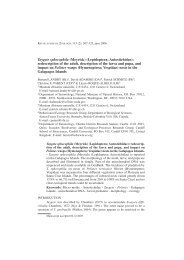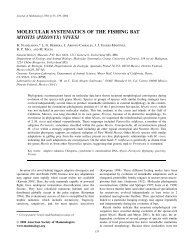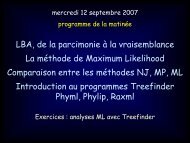72M. Holzmann et al. / Marine Micropaleontology 43 2001) 57±74this group and its ability to adapt to particular ecologicalconditions.Note added in pro<strong>of</strong>By courtesy <strong>of</strong> Dr. Gudmundsson, we received specimens<strong>of</strong> M. Kudakajimaensis and S. orbiculus var.marginalis that were originally from Pr<strong>of</strong>. J.J. Lee.Specimens <strong>of</strong> the latter two species were sampledalive in summer 1987 in a lagoon environment on KudakajimaOkinava, Japan), dried at room temperature andpreserved on micropaleontological slides. The M. kudakajimaensissample consisted <strong>of</strong> small specimenswhich, according to Dr. Gudmundsson, ªpresumablyare young specimens <strong>of</strong> M. kudakajimaensisº. DNAwas extracted from half <strong>of</strong> the test <strong>of</strong> one specimen <strong>of</strong>M. kudakajimaensis and one specimen <strong>of</strong> S. orbiculusvar. marginalis. Partial SSU rDNA was ampli®ed byPCR, cloned and sequenced. Sequence analysis showsthat M. kudakajimaensis branches with M. cf. kudakajimaenisi_afrom Sesoko, while S. orbiculus var. marginalisbranches with S.ˆorbiculus_h from Guam.AcknowledgementsWe would like to thank O. Jousson, X. Pochon, D.E. Williams and C. de Vargas for collecting samplesand J. Fahrni for technical assistance. Special thanksare extended to J.J. Lee for helping us collecting andde®ning part <strong>of</strong> the material. We are indebted to J.Montoya-Burgos for valuable discussions and helpfulsuggestions. The present study was supported by theAustrian `Fonds zur Foerderung der wissenschaftlichenForschung', project P12105-BIO M.H. andW.P.), and Swiss National Science Foundation grant3100-49513.96 J.P.). P. Hallock's collections in theFlorida Keys were supported by National Oceanic andAtmospheric Administration's National UnderseaResearch Program Subcontract No. 9703.66 and bythe US Environmental Protection Agency-ORD-STAR-GAD-R825869.ReferencesAdams, G.C., 1976. Larger Foraminifera and the late Cenozoichistory <strong>of</strong> the Mediterranean region. Paleogeogr. Paleoclimatol.Paleoecol. 20, 47±66.Blainville, H.M.D., 1830. Mollusques vers et Zoophytes. Dictionnairedes Sciences Naturelles, vol. 60. F.G. Levrault, Paris.Brady, H.B., 1884. Report on the Foraminifera dregded by H.M.S.Challenger, during the years 1873±1876. Report on the scienti®cresults <strong>of</strong> the voyage <strong>of</strong> H.M.S. Challenger, Zoology IX,vol. 22. H.M. Stationers, London, pp. 1±814 Atlas, pls. 1-116.Cahuzac, B., Poignant, A., 1997. Essai de biozonation de l'Oligo-MioceÁne dans les bassins europeÁens aÁ l'aide des grands foraminifeÁresneÂritiques. Bull. Soc. GeÂol. Fr. 168, 155±169.Carpenter, W.B., 1861. Researches on Foraminifera Ð fourth andconcluding series. Philos. Trans. R. Soc. London 150, 535±594.Cheng, T.C., Zheng, S., 1978. The recent Foraminifera <strong>of</strong> the XishaIslands Guangdong Province, China. Studia Marina Sinica 12,148±310.Cimerman, F., Langer, M.R., 1991. Mediterranean Foraminifera.Academia Scientiarum et. Artium Slovenica, Ljubljana, pp.118.Crapon de Caprona d'Ersu, A., 1983. Contribution aÁ l'eÂtude desSoritidae actuels ForaminifeÁres)-2: sous-famille des Peneroplinae.Rev. PaleÂobiol. 2, 87±125.Crapon de Caprona d'Ersu, A., 1985. Contribution aÁ l'eÂtude desSoritidae actuels ForaminifeÁres)-3: sous-familles des Archaiasinae,Meandropsininae et Soritinae et conclusions geÂneÂrales.Rev. PaleÂobiol. 4, 347±390.Cushman, J.A., 1930. Foraminifera <strong>of</strong> the Atlantic Ocean. Bull. USNat. Mus. 104, 1±79.D'Orbigny, A.D., 1839. ForaminifeÂres. In: Ramon de la Sagra Ed.),Histoire physique, politique et naturelle de l'Ile de Cuba, vol. 2,Zoologie. Paris, A. Bertrand: 224 pp.De Vargas, C., Norris, R., Zaninetti, L., Gibb, W.S., Pawlowski, J.,1999. <strong>Molecular</strong> evidence <strong>of</strong> cryptic speciation in planktonicforaminifers and their relation to oceanic provinces. Proc.Natl. Acad. Sci. USA 96, 2864±2868.Debenay, J.P., 1985. Recherches sur la seÂdimentation actuelle et lesthanatocoenoses des ForaminifeÁres de grande taille dans lelagoon sud-ouest et sur la marge insulaire sud de Nouvelle-Caledonie. Thesis, Univ. Aix-Marseille II, France, pp. 200.Felsenstein, J., 1988. Phylogenies from molecular sequences: inferenceand reliability. Annu. Rev. Genet. 22, 521±565.Fichtel, L. and Moll, J.P.C., 1798. Testacea microscopica, aliaqueminuta ex generibus Argonauta et Nautilus, ad naturam picta etdescripta. Vindobona, Camesina.Forskal, P., 1775. Descriptiones Animalium. Hauniae. CarstenNiebuhr, Copenhagen.Galtier, N., Gouy, M., 1996. seaview and phylo_win: two graphictools for sequence alignment and molecular <strong>phylogeny</strong>.Comput. Appl. Biosci. 12, 543±548.Gudmundsson, G., 1994. Phylogeny, ontogeny and systematics <strong>of</strong>Recent Soritacea Ehrenberg 1839 Foraminiferida). Micropaleontology40, 101±155.Haig, W.D., 1988. Miliolid Foraminifera from inner neritic sand andmud facies <strong>of</strong> the Papuan Lagoon, New Guinea. J. ForaminiferalRes. 18, 203±236.Hallock, P., 1988a. Diversi®cation in algal symbiont-bearing Foraminifera:a response to oligotrophy? Revue de Paleobiologie 2Benthos '86), 789±797.Hallock, P., 1988. Interoceanic differences in Foraminifera withsymbiotic algae: a result <strong>of</strong> nutrient supplies? Proceedings <strong>of</strong>
M. Holzmann et al. / Marine Micropaleontology 43 2001) 57±74 73the Sixth International Coral Reef Symposium, Townsville,Australia, 8±12 August 1988, 3: 251±255.Hallock, P., Peebles, W.M., 1993. Foraminifera with chlorophyteendosymbionts: habitats <strong>of</strong> six species in the Florida Keys. Mar.Micropaleontol. 20, 277±292.Hallock, P., RoÈttger, R., Wetmore, K., 1991. Hypotheses on formand function in Foraminifera. In: Lee, J.J., Anderson, O.R.Eds.), Biology <strong>of</strong> the Foraminifera. Academic Press, NewYork, pp. 41±72.Hallock, P., MuÈller-Karger, F.E., Halas, J.C., 1993. Coral ReefDecline Ð Anthropogenic Nutrients and the Degradation <strong>of</strong>Western Atlantic and Caribbean Coral Reefs. Res. Explor. 93), 358±378.Hallock, P., 1999. Symbiont-bearing Foraminifera. In: Sen Gupta,K.B. Ed.), Modern Foraminifera. Kluwer Academic Publishers,Dordrecht, pp. 123±140.Hatta, A., Ujiie, H., 1992. Benthic Foraminifera from the Coral Seasbetween Ishigaki and Iriomote Islands, Southern Ryukyu IslandArc, Northwest Paci®c. Part 1. Systematic descriptions <strong>of</strong>Textulariina and Miliolina. Bull. Coll. Scie. Univ. Ryukyus53, 49±119.Haynes, J.R., 1981. Foraminifera. Wiley, New York.Hillis, D.M., Bull, J.J., 1993. An empirical test <strong>of</strong> bootstrapping asamethod for assessing con®dence in phylogenetic analysis. Syst.Biol. 42, 182±192.H<strong>of</strong>ker, J., 1930. The Foraminifera <strong>of</strong> the Siboga expedition, part II.Siboga-Expeditie Monografen. No. 4a. E. J. Brill, Leiden.H<strong>of</strong>ker, J., 1950. Recent Peneroplidae Part I. J. R. Microscop. Soc.London 70, 388±396.H<strong>of</strong>ker, J., 1951. Recent Peneroplidae, Part III. Genus Puteolinanov. gen. including the former genus Archaias). J. R. Microscop.Soc. London 71, 450±463.H<strong>of</strong>ker, J., 1952. Recent Peneroplidae Part IV. Genus Orbitolites. J.R. Microscop. Soc. London 72, 102±122.H<strong>of</strong>ker, J., 1953. Recent Peneroplidae Part V. Reproduction <strong>of</strong> thePeneroplidae. J. R. Microscop. Soc. London 73, 40±46.Hohenegger, J., 1994. Distribution <strong>of</strong> living <strong>large</strong>r ForaminiferaNW <strong>of</strong> Sesoko-Jima Okinawa, Japan. Mar. Ecol. 15, 291±334.Hohenegger, J., Yordanova, E., Nakano, N., Tatzreiter, F., 1999.Habitats <strong>of</strong> <strong>large</strong>r Foraminifera on the upper reef slope <strong>of</strong>Sesoko Island, Okinawa, Japan. Mar. Micropaleontol. 36,109±168.Holzmann, M., Pawlowski, P., 1996. Preservation <strong>of</strong> Foraminiferafor DNA extraction and PCR Ampli®cation. J. ForaminiferalRes. 26, 264±267.Hottinger, L., 1983. Reconstruction <strong>of</strong> Marine Paleoenvironments.In: Meulenkamp, J.E. Ed.), Processes determining the distribution<strong>of</strong> <strong>large</strong>r Foraminifera in space and time. Utrecht Micropaleontol.Bull. 30, 239±253.Kimura, M., 1980. A simple method for estimating evolutionaryrates <strong>of</strong> base substitutions through comparative studies <strong>of</strong>nucleotide sequences. J. Mol. Evol. 16, 111±120.Lamarck, J.B., 1816. Histoire naturelle des animaux sans verteÂbres.Histoire naturelle des animaux sans verteÂbres, vol. 2. VerdieÂre,Paris.Langer, M.R., Hottinger, L., 2000. Biogeography <strong>of</strong> selected`<strong>large</strong>r' Foraminifera. Micropaleontology 46 suppl. 1), 105±126.Larsen, N., Olsen, G.J., Maidak, B.L., McCaughey, M.J., Overbeek,R., Macke, T.J., Marsh, T.L., Woese, C.R., 1993. The ribosomaldatabase project. Nucl. Acids Res. 21, 3021±3023.Lee, J.J., Hallock, P., 1987. Algal symbiosis as a driving force in theevolution <strong>of</strong> <strong>large</strong>r Foraminifera. Ann. New York Acad. Sci.503, 330±347.Lee, J.J., 1990. Fine structure <strong>of</strong> the rhodophycean Porphyridiumpurpureum in situ in Peneroplis pertusus Forskal) and P. acicularisBatsch) and in axenic culture. J. Foraminiferal Res. 20,162±169.Lee, J.J., Anderson, O.R., 1991. Symbiosis in Foraminifera. In: Lee,J.J., Anderson, O.R. Eds.), Biology <strong>of</strong> Foraminifera. AcademicPress, London.Lehmann, R., 1961. Strukturanalyse einiger Gattungen der SubfamilieOrbitolitinae. Ecol. Geol. Helv. 54, 597±667.Leutenegger, S., 1984. Symbiosis in benthic <strong>foraminifera</strong>: speci®cityand host adaptation. J. Foraminiferal Res. 14, 16±35.Levy, A., 1977. ReÂvision micropleÂontologique des Soritidae actuelsBahamiens, Un nouveau genre: Androsina. Bull. Cent. Rech.Explor.-Prod. Elf-Aquitaine 1, 393±449.Lockhart, P.J., Steel, M.A., Hendy, M.D., Penny, D., 1994. Recoveringevolutionary trees under a more realistic model <strong>of</strong>sequence evolution. Mol. Biol. Evol. 2, 605±612.Loeblich, A.J.R., Tappan, H., 1964. Sarcodina chie¯y ªThe camoebiansª and Foraminiferida. In: Moore, R.C. Ed.), Treatise onInvertebrate Paleontology, part C, 1±2. Geological Society <strong>of</strong>America and <strong>University</strong> <strong>of</strong> Kansas Press, Lawrence, p. 900.Loeblich, A.J.R., Tappan, H., 1988. Foraminiferal Genera andtheir Classi®cation, vol. 1±2. Van Nostrand Reinhold, NewYork.McEnery, M., Lee, J.J., 1981. Cytological and ®ne structural studies<strong>of</strong> three species <strong>of</strong> symbiont-bearing <strong>large</strong>r Foraminifera fromthe Red Sea. Micropaleontology 27, 71±83.Munier-Chalmas, E., 1882. Un genre nouveau de foraminifeÁresseÂnoniens. Bull. Soc. GeÂol. France, seÂr. 3 10, 471±472.Neefs, J.M., Van der Peer, Y., De Rijk, P., Chapelle, S., De Wachter,R., 1993. Compilation <strong>of</strong> small ribosomal subunit RNAstructures. Nucl. Acids Res. 21, 3025±3049.Olsen, G.J., Matsuda, H., Hagstrom, R., Overbeek, R., 1994. FastDNAml: A tool for construction <strong>of</strong> phylogenetic trees <strong>of</strong> DNAsequences using maximum likelihood. Comput. Appl. Biosci.10, 41±48.Pawlowski, J., Bolivar, I., Fahrni, J.F., de Vargas, C., Bowser, S.,1999. <strong>Molecular</strong> evidence that Reticulomyxa ®losa is a freshwaternaked foraminifer. J. Eukaryot. Microbiol. 46, 612±617.Pawlowski, J., 2000. Introduction to the molecular systematics <strong>of</strong><strong>foraminifera</strong>. Micropaleontology 46 suppl. 1), 1±112.Pawlowski, J., Holzmann, M., Fahrni, J., Hallock, E., 2001a. <strong>Molecular</strong>identi®cation <strong>of</strong> algal endosymbionts in <strong>large</strong> <strong>miliolid</strong>foraminifers 1 chlorophytes. J. Eukaryot. Microbiol. 48, 362±367.Pawlowski, J., Holzmann, M., Fahrni, J., Pochon, X., Lee, J.J.,2001b. <strong>Molecular</strong> identi®cation <strong>of</strong> algal endosymbionts in<strong>large</strong> <strong>miliolid</strong> foraminifers: 2 Dino¯agellates. J. Eukaryot.Microbiol. 48, 368±373.






